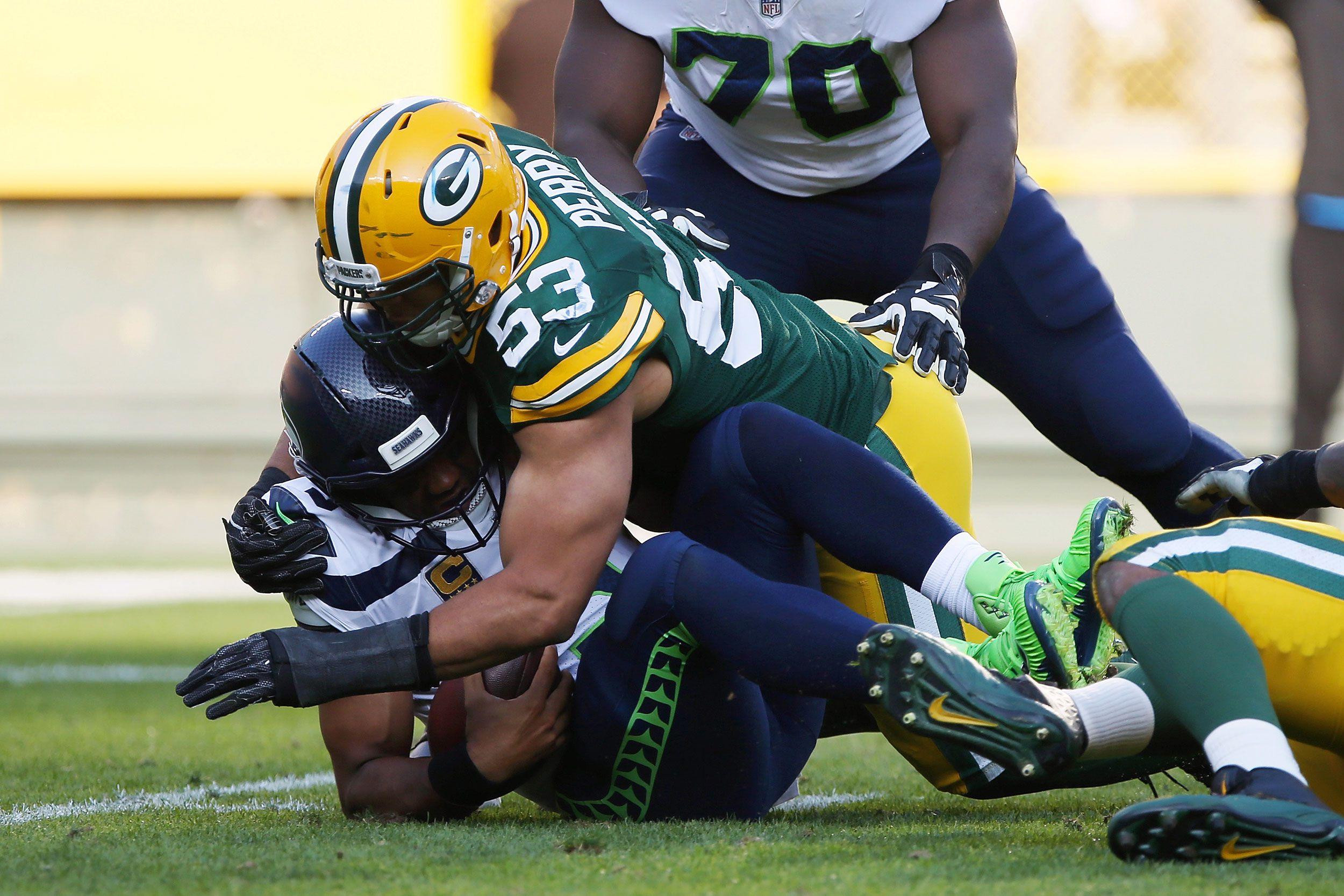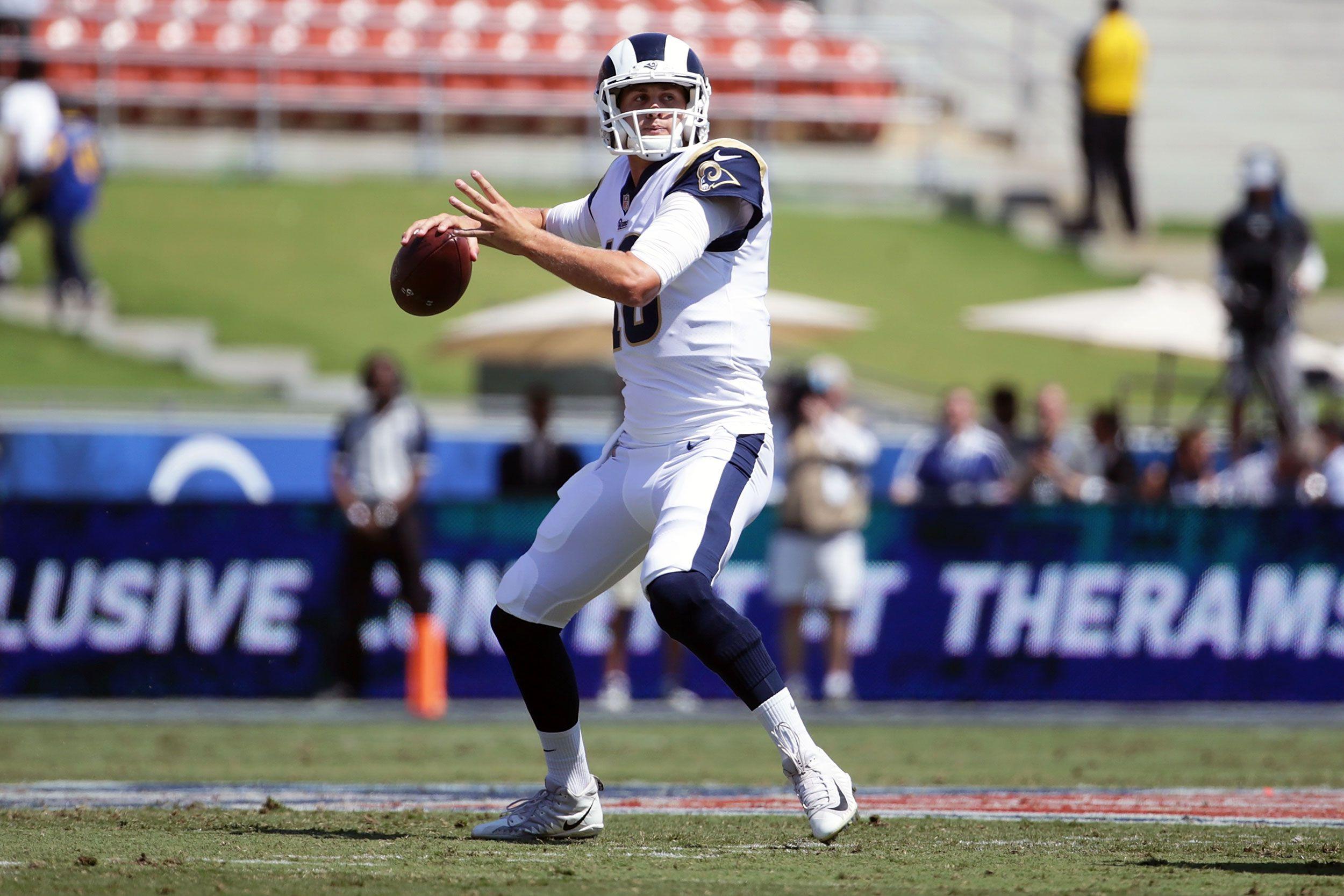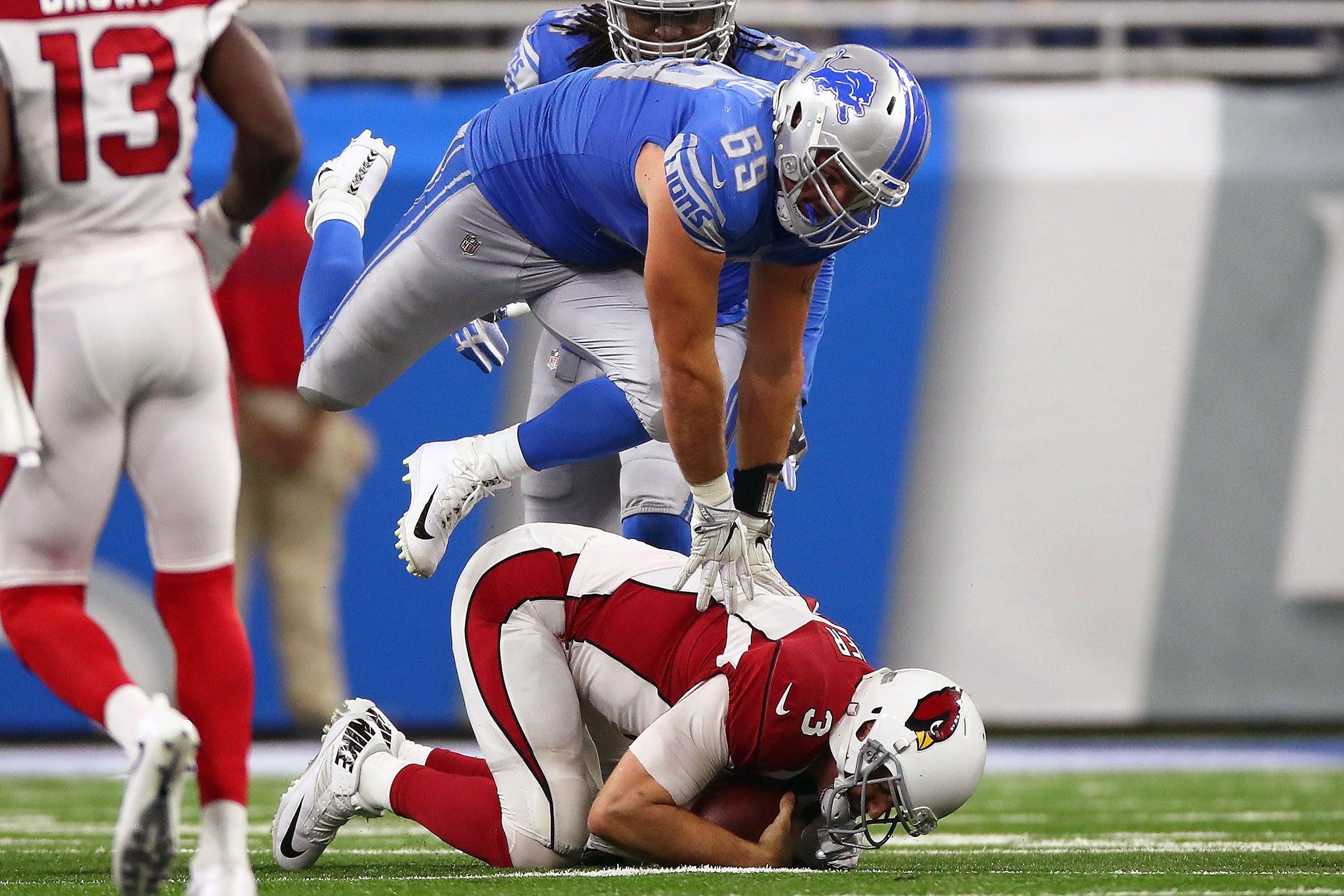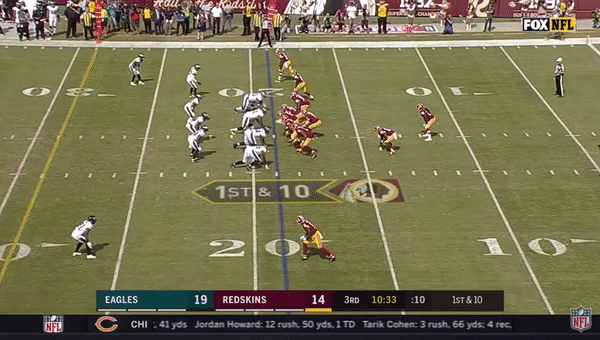Click here for all our Week 1 coverage.
Week 1 of the NFL season traditionally provides a glimpse at how the teams we saw last season have changed. It’s often full of surprises, like when Alex Smith and the Chiefs went into Foxborough on Thursday night and stomped the defending champion Patriots 42-27 with a deep-strike offense that rained fire from the sky. For the projected contenders in the NFC, though, Sunday’s season-opening performances were mostly worthy of a looped audiotape of the late Denny Green: They are who we thought they were.
The Seahawks offensive line basically ceased to exist in a 17-9 loss to the Packers. The Giants defense looked formidable for most of a 19-3 loss to the Cowboys, but their offense failed to get anything going without injured wide receiver Odell Beckham Jr. And while the Falcons showed flashes of their 2016 form in a 23-17 victory over the Bears, they also hinted at offensive regression in the way that many predicted.
The two teams that showed continuity in the right areas and inspired cause for optimism in others were the Packers and Cowboys. Not coincidentally, they notched what could go down as the two most critical wins of Week 1.
Let’s start with Green Bay. Aaron Rodgers finished 28-of-42 passing for 311 yards with a touchdown and an interception, and the Packers offense shook off a sluggish start to score on three of their five second-half possessions and improve to 1-0. Yet the more significant development may have been the showing of the defense, which finished 20th in Football Outsiders’ DVOA last fall—one spot above the lowly Jets. It pressured Seahawks quarterback Russell Wilson on a ridiculous 39.4 percent of his dropbacks, according to Pro Football Focus, as defensive end Mike Daniels and edge rusher Nick Perry terrorized Seattle left tackle Rees Odhiambo and left guard Luke Joeckel. Wilson was barely given a chance to operate, and he largely flailed even in the rare moments when he did have time to work.
Seattle’s pervasive issue is that its offensive and defensive lines exist in diametric opposition to each other. It feels like the universe’s method of balancing the scales. The defense adding Sheldon Richardson in a recent trade and allowing Cliff Avril to become an even more terrifying presence meant that the offensive line had to get even worse. And Sunday, the same flaw that doomed this team in January’s playoff loss to the Falcons was on full display. Playing against the Seahawks offensive line can have a similar effect as looking in a fun-house mirror: it distorts reality, to the point where it was hard to tell where that group’s deficiencies ended and Green Bay’s strengths began. Still, defense was the Packers’ downfall last season, and this was a good first step toward addressing that problem.

The Cowboys’ effort Sunday was equally encouraging. This squad went 13-3 and won the NFC East last season primarily because of its offense, and that unit’s upside was apparent once again: Running back Ezekiel Elliott, who remains on the field for now after a temporary restraining order handed down Friday lifted his six-game suspension, carried 24 times for 104 yards, while quarterback Dak Prescott was solid against a foe that gave him fits as a rookie. Yet it was the defense’s showing that could turn out to be more notable. Defensive end DeMarcus Lawrence wreaked havoc on the Giants offensive line, and for at least one week a Dallas group lined with question marks appeared up to the task. It helped that linebacker Sean Lee played like he could see into the future; I mean, just look at this.
The Giants offense, much like Seattle’s, may not offer the best measuring stick, though. While the New York front office added pieces like tight end Evan Engram and wide receiver Brandon Marshall this offseason to give Eli Manning’s crew another dimension, the unit looked lost in Dallas. The 2016 Giants finished 26th in the league in scoring offense (19.4 points per game); with superstar receiver Beckham out with an ankle injury, the Giants looked … well, like last season’s team would’ve looked without Beckham. They generated 13 first downs and six punts. Marshall’s only catch came on the final play of the fourth quarter.
It’s worth mentioning last season’s NFC Super Bowl representative here, too, as the Falcons beat the Bears in a game in which reigning MVP Matt Ryan passed for 321 yards. Yet the offense that laid waste to opponents in 2016 seemed out of rhythm in spurts. An 88-yard touchdown toss to tight end Austin Hooper on a play with busted coverage provided a cosmetic upgrade to Ryan’s stats, and Atlanta ended the game with two fewer first downs than the Bears (20 to 18). Kinks should be expected as the team transitions from coordinator Kyle Shanahan to successor Steve Sarkisian, but it’s nonetheless noteworthy that the Falcons had six three-and-outs after recording 24 all of last season. New right guard Wes Schweitzer had a nightmarish debut against Bears stud defensive lineman Akiem Hicks (two sacks and three quarterback hits), and if Chicago’s Jordan Howard hadn’t dropped a pass near the goal line, this might’ve gone the other way.
Week 1 brought more chalk than chaos, although the carryover from the 2016 season manifested itself in different ways among the likely class of the NFC. Plenty can and will change in the coming weeks, but for now Green Bay and Dallas should be content with their initial impressions. Both teams would love for Denny Green’s words to ring true, because in both cases, what we thought they were was NFL heavyweights.

The Starting 11
A look at 11 big story lines, key developments, and interesting tidbits from this week in the NFL.
1. Jared Goff looked like an entirely different person under new Rams head coach Sean McVay. When the 31-year-old McVay took the top job in Los Angeles in January, his first, second, and third priorities immediately became fixing Goff. One game in, the pairing seems to be on the right track. Goff, who had a disastrous rookie campaign, turned in his best day as a pro (21-of-29 passing for 306 yards with a touchdown) in a 46-9 rout of a Colts team that looked hapless on both sides of the ball. Even taking Indianapolis’s floundering into account, Goff was strikingly competent. He could have put together this type of day against Lawrence Central High School, and it still would have been more impressive than any of his showings from 2016.
What stood out most was how comfortable Goff looked—both with his decision-making and with this offense. He had no qualms pushing the ball down the field, and, in receivers Sammy Watkins and rookie Cooper Kupp, L.A. has found two useful weapons to bring along the new and improved version of Goff. There’s a chance that this Colts season will go south in a hurry (with or without Andrew Luck), but that shouldn’t take away from Goff’s improvement. The Rams’ hopes hinge on what McVay gets from a passer the front office traded years’ worth of draft assets for; he’s one for one.
2. Tom Savage lasted all of two quarters in Houston; Deshaun Watson’s time has begun. Or maybe not. Who the hell knows with Houston head coach Bill O’Brien? During the four and a half months since the Texans traded up to take Watson in the first round of this year’s draft, O’Brien told anyone who would listen that Savage was his quarterback. It took the coach 30 minutes of action to change his mind. I’ve spent more time deciding whether to buy a pair of jeans.
Savage went 7-of-13 passing for 62 yards before he was yanked, although the larger concern is that he was sacked six times in two quarters. He didn’t stand a chance behind an overmatched offensive line. Watson didn’t fare much better once he came in; the Clemson product was dropped four times. The Texans’ lone touchdown drive (on Watson’s first possession) in a 29-7 loss to Jacksonville was made possible only because a roughing the passer call wiped out a third-and-20. Three plays later, an interception was called off because of an illegal hands to the face penalty.
Watson entered this fall as the 2017 first-round quarterback most likely to see early snaps, as Houston isn’t invested in Savage in the same way that Chicago is in Mike Glennon. But it looks as if Watson is walking into a snake pit. The Texans’ front seemed lost without left tackle Duane Brown, whose holdout continued into Week 1. While the Jaguars have spent a modest fortune bolstering their defensive line, their double-digit sack total was a three-hour argument for why Houston needs Brown back in the fold.
3. Welcome to Sacksonville, where the Jags’ offseason plan was on full display. The Jaguars gave former Cardinals defensive end Calais Campbell a four-year, $60 million deal in March with the hope that he’d finally lift their front four to the next level. Boy, did it look like that move paid off Sunday. The 31-year-old racked up four sacks in the first half as the Jags piled up 10 against the Texans.
Campbell had the best day of anyone on Jacksonville’s defensive line, but he was far from the only standout. The combination of Campbell, Malik Jackson, and second-year defensive end Yannick Ngakoue has some serious game-wrecking potential. And it’s just part of the formula the Jags want to use this season. By drafting LSU running back Leonard Fournette fourth overall and grabbing Alabama left tackle Cam Robinson in Round 2, this team made a clear pivot to embracing a more physical brand of offense. It showed in Week 1’s win over Houston, as Fournette carried 26 times for 100 yards with a touchdown. Fournette and Chris Ivory combined for 35 rushes; quarterback Blake Bortles attempted just 21 passes.
Jacksonville’s 19-point halftime lead played a role in that split, but it’s obvious that the offense’s plan (especially with receiver Allen Robinson lost for the season to an ACL injury) is to mitigate Bortles’s impact. Through one week, that looks like it’s the right approach.
4. The Raiders offense picked up right where it left off—and now it has Marshawn Lynch. Oakland’s passing game looked potent against a revamped Titans secondary, as wide receivers Amari Cooper and Michael Crabtree both finished with at least five catches in a 26-16 win. Crabtree came down with a pair of absurd grabs along the sideline, and with the offensive line dominating Tennessee’s solid front four, Sunday offered a reminder of how complete Oakland’s attack really is.
Holding onto a one-score lead late in the game, the Raiders turned to Lynch, who hammered his way down the field to get the team in field goal range and put the game out of reach. Even the staunchest Lynch fans among us had to temper expectations for the running back coming into the season, as the 31-year-old was set to take the field after a full year out of the league. If Sunday’s 18-carry, 76-yard performance is any indication, though, he can provide Oakland with a ground-game dynamic that it’s lacked in years past. For the first time since the Raiders’ game-changing offensive line has been together, it feels like that unit has a backfield counterpart that shares its trademark nastiness.

5. The Cardinals might have been the most disappointing team in Week 1, and their path doesn’t figure to any get easier from here. Arizona’s offense struggled to get anything clicking in a 35-23 loss to the Lions. While the Cards kept the game close for most of the afternoon, that happened only because Matthew Stafford threw an awful pick-six and Detroit made some horrendous special teams miscues.
Arizona quarterback Carson Palmer had a miserable outing, going 27-of-48 passing with three picks and a slew of head-scratching throws. Typically, the Cardinals could offset Palmer struggling with a game plan centered on David Johnson, but that wasn’t an option either in this case. Johnson had just 23 yards on 11 carries before exiting the game with a wrist injury. Initial reports suggest that he could miss significant time with a sprain, which is the sort of news that could sink this Arizona season before it really begins. No running back is more vital to his team’s success; without Johnson, the Cardinals’ ability to manufacture yards when operating at less than full capacity goes completely out the window.
Arizona’s other big problem was an ineffective offensive line, as it showed many of the same issues that plagued it in 2016, especially after former first-round pick D.J. Humphries went down with a knee injury and was replaced by John Wetzel. Wetzel had his hands full with career backup Cornelius Washington—which doesn’t bode well for a team in a division that features Michael Bennett and Robert Quinn. Several factors that could help the Cardinals bounce back from a disheartening 2016 campaign just went the wrong direction in a hurry.
6. The Bengals offensive line looks as putrid as expected. Funny how this works: A group that was actively bad last season loses its two best blockers; in a shocking twist, that unit gets even worse! Cincinnati was decimated up front Sunday, as the Ravens rolled to a 20-0 win behind a pass rush that should give opponents fits all season. Baltimore’s trio of Brandon Williams, Terrell Suggs, and Michael Pierce controlled the entire game. Bengals quarterback Andy Dalton finished 16-of-31 passing for 170 yards with four interceptions and a lost fumble. His outing was about as gruesome as those numbers suggest.
Unlike in places like Houston, Arizona, or even Green Bay (where Bryan Bulaga’s absence allowed Cliff Avril to have a nice afternoon), Cincy’s woes aren’t the byproduct of injuries or holdouts. The Bengals fielded this line on purpose. It looks as if they’ll reap the horrors of that decision all season.
7. Tarik Cohen brought a much-needed jolt of energy to the Bears offense. The fourth-round pick out of North Carolina A&T was the talk of training camp, and he showed why Sunday. Damn, is he fun. Cohen finished his debut with 13 touches, 113 total yards, and a touchdown.
Cohen came into this fall billed as a suitable complement to workhorse back Jordan Howard. If his Week 1 usage is a sign of things to come, the 5-foot-6 playmaker will take on a featured role in Chicago’s offense. And with wide receiver Kevin White likely done for the season with a broken collarbone, the team is going to need him. Cohen tallied 12 targets against Atlanta—twice as many as any other Bears pass catcher. With 2016 breakout star Cam Meredith already lost for the season to a torn ACL, Cohen might be the most dangerous receiving option Chicago has.
8. 49ers linebacker Reuben Foster’s ankle injury is a depressing blow for San Francisco. The 2017 first-round pick was everywhere early in Sunday’s 23-3 loss to the Panthers, flying around the ball and diagnosing route concepts in impressive fashion. Then he had to be carted off the field with 3:47 left in the first quarter. New head coach Kyle Shanahan’s team is a work in progress, and wins and losses this season are likely less important than progress from its young core. That latter goal would take a major hit if Foster were forced to miss extended time.
9. This week’s line-play moment that made me hit rewind: Timmy Jernigan’s third-quarter burial of Washington’s Kirk Cousins. By adding Jernigan, Chris Long, and Derek Barnett to an already stacked Eagles defensive line this offseason, coordinator Jim Schwartz now has a stable of pass-rushing talent that can stack up to any in football. And in Week 1’s 30-17 win, those players came out like men possessed.

Philadelphia piled up four sacks and eight quarterback hits, and even those numbers don’t do justice to just how much the Eagles got to Cousins throughout Sunday’s game. One of the reasons that Philly’s pass rush stalled at times last season was that opponents were able to slide their protection toward star defensive tackle Fletcher Cox and dare run-stuffing nose tackle Bennie Logan to beat them. With Jernigan in the fold, the Eagles boast a penetrating skill set at that second defensive tackle spot. Just ask Washington left guard Shawn Lauvao.
10. This week in tales of the tape: Christian McCaffrey’s usage and influence are going to extend beyond the plays on which he touches the ball.
On this first-and-goal from San Francisco’s 9-yard line, the Panthers lined up with two tight ends to the right side and McCaffrey offset as a fullback in front of veteran running back Jonathan Stewart. At the snap, McCaffrey tears into the flat, taking a linebacker with him and opening up space for Stewart to corral an easy throw from Cam Newton and turn upfield. With room to work and McCaffrey already in place to deliver a key block, Stewart is able to squeeze his way into the end zone.
McCaffrey’s production in his debut—18 touches for 85 total yards—was buoyed by his late work with a Carolina victory already in hand. As this play showed, though, it’ll be fascinating to see how the Panthers take advantage of his unique skill set all season long.
11. This week in NFL players, they’re absolutely nothing like us: T.J. Watt caps off his debut by levitating for an interception.
Watt’s two-sack outing generated plenty of excitement in Pittsburgh, as the rookie’s presence was felt throughout the Steelers’ 21-18 victory over the Browns. The team should lean on him even more going forward now that Stephon Tuitt—who looked excellent with a pressure on the first play of the game and who recorded a tackle for loss on the next snap—could possibly miss the remainder of the season with a biceps injury.